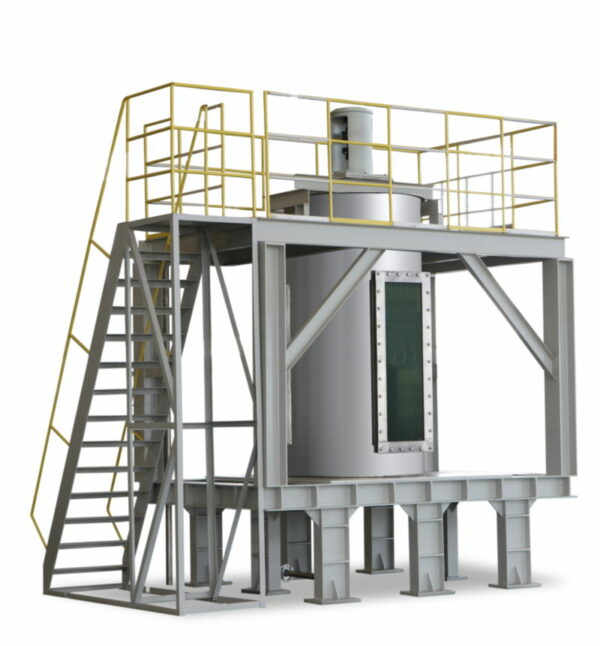Lime bin and agitator tank are important components used in filter press applications to treat wastewater.
Here’s how they function and their importance:
Lime Bin:
A lime bin is a container used to store lime, which is a commonly used chemical used in wastewater treatment for pH adjustment, coagulation, and flocculation. The lime bin is typically made of steel or concrete and is designed to prevent contamination of the lime.
The lime is added to the wastewater to adjust the pH and to form floc for removal by the filter press. The lime is typically added to the wastewater upstream of the filter press to ensure proper pH adjustment and to aid in the formation of floc.
Agitator Tank:
An agitator tank is used to mix the lime and other chemicals with the wastewater, ensuring that the chemicals are evenly distributed throughout the wastewater before it enters the filter press. The agitator tank is typically a cylindrical tank with an agitator blade in the center that rotates to mix the contents.
The agitator tank is important in filter press applications as it ensures that the chemicals are properly mixed and distributed throughout the wastewater. This ensures that the chemicals can effectively adjust the pH and form floc for removal by the filter press.
In summary, lime bin and agitator tank are important components used in filter press applications to treat wastewater. The lime bin is used to store lime, which is added to the wastewater to adjust the pH and form floc for removal by thefilter press. The agitator tank is used to mix the lime and other chemicals with the wastewater, ensuring that the chemicals are evenly distributed throughout the wastewater before it enters the filter press. By utilizing these components, the pH of the wastewater can be properly adjusted and flocs can be effectively formed for removal by the filter press, resulting in efficient and effective wastewater treatment.
What are some other chemicals used in wastewater treatment?
There are several chemicals used in wastewater treatment to help remove impurities and contaminants from the water.
Here are some other chemicals commonly used in wastewater treatment:
Coagulants: Coagulants are chemicals used to neutralize the charge on suspended particles in the wastewater, causing them to clump together and form larger particles that can be more easily removed by filtration. Common coagulants used in wastewater treatment include aluminum sulfate, ferric chloride, and polyaluminum chloride.
Flocculants: Flocculants are chemicals used to promote the formation of larger particles, or flocs, from the smaller particles in the wastewater. This process helps to improve the efficiency of filtration and settling processes. Common flocculants used in wastewater treatment include polyacrylamides and natural polymers such as chitosan.
pH Adjusters: pH adjusters are chemicals used to adjust the pH of the wastewater to a range that is more conducive to wastewater treatment processes. Common pH adjusters used in wastewater treatment include lime, sodium hydroxide, and sulfuric acid.
Disinfectants: Disinfectants are chemicals used to kill or inactivate harmful microorganisms in the wastewater. Common disinfectants used in wastewater treatment include chlorine, ozone, and ultraviolet light.
Activated Carbon: Activated carbon is a porous material that is used to adsorb impurities in the wastewater. How Lime Bin And Agitator Tank For Filter Press Application It is effective at removing organic compounds, suchas pesticides, solvents, and other contaminants. Activated carbon can be used in both primary and secondary treatment processes.
Oxidants: Oxidants are chemicals used to break down or destroy organic compounds in the wastewater. Common oxidants used in wastewater treatment include hydrogen peroxide, potassium permanganate, and ozone.
Biological Nutrients: Biological nutrients, such as nitrogen and phosphorus, can be added to the wastewater to promote the growth of microorganisms that can remove these nutrients from the wastewater. This process, called biological nutrient removal, can help prevent eutrophication and other environmental problems associated with excessive nutrient levels.
In summary, there are several chemicals used in wastewater treatment to help remove impurities and contaminants from the water. Coagulants, flocculants, pH adjusters, disinfectants, activated carbon, oxidants, and biological nutrients are all commonly used in wastewater treatment processes depending on the specific needs of the application. The selection of chemicals and dosages used will depend on the characteristics of the wastewater being treated and the desired treatment objectives. Consulting with a qualified engineer or wastewater treatment professional can help identify the appropriate chemicals and treatment processes for a given application.

